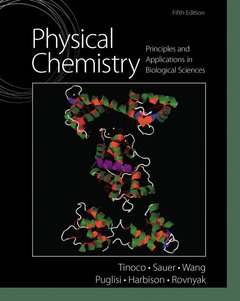Physical Chemistry (5th Ed.) Principles and Applications in Biological Sciences
Auteurs : Tinoco Ignacio, Sauer Kenneth, Wang James, Puglisi Joseph, Harbison Gerard, Rovnyak David

Introducing readers to the latest research applications, the new Fifth Edition of the bestselling Physical Chemistry: Principles and Applications in Biological Sciences puts the study of physical chemistry in context. Clear writing and the ideal level of mathematics combine for an engaging overview of the principles and applications of contemporary physical chemistry as used to solve problems in biology, biochemistry, and medicine.
Brief Contents
- Chapter 1: Introduction
- Chapter 2: The First Law: Energy is Conserved
- Chapter 3: The Second Law: The Entropy of the Universe Increases
- Chapter 4: Free Energy and Chemical Equilibria
- Chapter 5: The Statistical Foundations of Biophysical Chemistry
- Chapter 6: Physical Equilibria
- Chapter 7: Electrochemistry
- Chapter 8: The Motion of Biological Molecules
- Chapter 9: Kinetics: Rates of Chemical Reactions
- Chapter 10: Enzyme Kinetics
- Chapter 11: Molecular Structures and Interactions: Theory
- Chapter 12: Molecular Structures and Interactions: Biomolecules
- Chapter 13: Optical Spectroscopy
- Chapter 14: Magnetic Resonance
- Chapter 15: Macromolecular Structure and X-Ray Diffraction
Ignacio Tinoco was an undergraduate at the University of New Mexico, a graduate student at the University of Wisconsin, and a postdoctoral fellow at Yale. He then went to the University of California, Berkeley, where he has remained. His research interest has been on the structures of nucleic acids, particularly RNA. He was chairman of the Department of Energy committee that recommended in 1987 a major initiative to sequence the human genome. His present research is on unfolding single RNA molecules by force.
Kenneth Sauer grew up in Cleveland, Ohio, and received his A.B. in chemistry from Oberlin College. Following his Ph.D. studies in gas-phase physical chemistry at Harvard, he spent three years teaching at the American University of Beirut, Lebanon. A postdoctoral opportunity to learn from Melvin Calvin about photosynthesis in plants led him to the University of California, Berkeley, where he has been since 1960. Teaching general chemistry and biophysical chemistry in the Chemistry Department has complemented research in the Physical Biosciences Division of the Lawrence Berkeley National Lab involving spectroscopic studies of photosynthetic light reactions and their role in water oxidation. His other activities include reading, renaissance and baroque choral music, canoeing, and exploring the Sierra Nevada with his family and friends.
James C. Wang was on the faculty of the University of California, Berkeley, from 1966 to 1977. He then joined the faculty of Harvard University, where he is presently Mallinckrodt Professor of Biochemistry and Molecular Biology. His research focuses on DNA and enzymes that act on DNA, especially a class of enzymes known as DNA topoisomerases. He has taught courses in biophysical chemistry and molecular biology and has published over 200 research articles. He is a member of Academia Sinica, the A
- A streamlined treatment covers the core aspects of biophysical chemistry (thermodynamics and kinetics as well as quantum mechanics, spectroscopy, and X-ray diffraction), which are of great importance to students of biology and biochemistry. Essentially all applications of the concepts are of interest to life-science students; nearly all the problems apply to life-science examples.
- Clear, explicit writing helps students, especially those with weaker math skills, cement their conceptual understanding of physical chemistry
- An appropriate level of mathematics uses elementary calculus to derive equations and carefully defines the scope of mathematics needed to solve problems.
- Emphasis on methods such as modern fluorescence, calorimetry and single molecule techniques introduces students to techniques that are important in biochemistry and molecular biology
- Theory of molecular structure and interactions begins with the origins of quantum mechanics, and builds up to intermolecular and intramolecular forces and the use of semi-empirical methods to calculate molecular conformation, giving students a better understanding of the concepts and methods used to calculate and predict macromolecular structures
- Emphasis on nuclear magnetic resonance and fluorescence spectroscopy provides an in-depth look at the two main methods used to study proteins and nucleic acids in solution.
- Updated coverage of molecular structures and X-ray diffraction (Ch. 15) offers a detailed discussion of how a structure is obtained from a measured diffraction pattern. X-ray diffraction available to non-specialists to determine structures of proteins and nucleic acids.
Date de parution : 10-2012
Ouvrage de 696 p.
20.6x25.7 cm



